|
|
|
Sort Order |
|
|
|
Items / Page
|
|
|
|
|
|
|
| Srl | Item |
| 1 |
ID:
142540
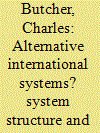

|
|
|
|
|
| Summary/Abstract |
Were precolonial state systems different to the European model? If so, how did these state systems vary, and do variations in system structure influence the frequency of war? In this article we assess the structure off international systems in nineteenth-century West Africa, Southeast Asia, and South Asia using new data on precolonial states that corrects for some of the biases in the existing Correlates of War state system membership data. We develop a framework to capture variation in political order above and below the state, and explore the similarities and differences between these systems and the European system we know and study. We then assess how rates of inter- and intra-state war varied across these systems. Our results suggest: (1) It is the nature of hierarchy (not so much anarchy) that varies across these systems; and (2) inter-state wars are more frequent, but less intense, in systems composed of decentralised states.
|
|
|
|
|
|
|
|
|
|
|
|
|
|
|
|
| 2 |
ID:
127707
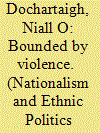

|
|
|
|
|
| Publication |
2013.
|
| Summary/Abstract |
This article analyzes the relationship between territoriality and organized violence through an examination of two relatively understudied aspects of the production and reproduction of informal territorial boundaries in situations of violent conflict. It looks first at the role of the state in the establishment, maintenance, and institutionalization of substate territories associated with challengers, outlining how these bounding processes are generated through interaction between the state and challengers, rather than primarily through the actions of challengers. Secondly, it explores the shaping force of geopolitical contexts on the everyday maintenance of informal boundaries in conflict situations. The argument is illustrated with examples from the most recent period of violent conflict in the north of Ireland, drawing on a range of primary sources, including official and private papers. The article argues that an analysis that gives due recognition to the central role of the state and the importance of the geopolitical context in the delineation and institutionalization of substate territories associated with armed challengers can help us to better understand the dynamics of organized violence.
|
|
|
|
|
|
|
|
|
|
|
|
|
|
|
|
| 3 |
ID:
069180
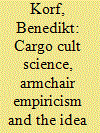

|
|
|
| 4 |
ID:
178652
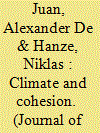

|
|
|
|
|
| Summary/Abstract |
While a large body of research has highlighted the conflict-inducing effects of climate change, we still know very little about the mechanisms linking environmental conditions to violent conflict. This article investigates the plausibility of a prominent channel according to which scarcity of natural resources can foster violent conflict through deteriorating intergroup relations. In addition to assessing the direct effects of adverse environmental conditions on intra-ethnic and inter-ethnic trust, we suggest a conditional argument on the role of horizontal inequality of hazard exposure. Environmental hazards are ‘unequal’ if they systematically affect ethnic groups differently. While inequality may reinforce intra-ethnic ties and out-group suspicion, equal hazard exposure may create a sense of unity among diverse victims in their collective struggle to cope with harsh environmental conditions. We test these arguments in the context of the severe drought periods that affected most East African countries in the years 2004 and 2005. The empirical analysis combines gridded information on drought severity with geo-located survey data across six countries in the region (Afrobarometer survey 2005/2006). Our main analyses find that exposure to drought hazards correlates positively with self-reported trust within and across ethnic groups. The latter association, however, depends on the degree of intergroup equality of hazard exposure and wanes as inequality increases. Taken together, these findings indicate that if droughts increase the risk of violent conflict, they seem to do so through mechanisms other than intergroup polarization and despite their positive association with ethnic trust. This is most likely the case in contexts where there is pronounced horizontal inequality of drought hazards.
|
|
|
|
|
|
|
|
|
|
|
|
|
|
|
|
| 5 |
ID:
163750


|
|
|
|
|
| Summary/Abstract |
How does climate change affect the risk and dynamics of violent conflict? Existing research shows that climate change can increase the risk of violent conflict and significantly alter the dynamics of existing conflicts. Less is known about the exact mechanisms through which climate change affects violent conflict. In this article, we address this lacuna in light of the first systematic review of both quantitative and qualitative scholarship. Through an analysis of forty-three peer-reviewed articles on climate-related environmental change and violent conflict in East Africa published 1989–2016, we evaluate to what extent the literature provides coherent explanations that identify relevant mechanisms, actors, and outcomes. In addition, we discuss the expected temporal and spatial distribution of violence and the confounding political factors implied in the literature. Against this background, we offer a number of suggestions for how future climate-conflict research can theorize and explore mechanisms. Future research should distinguish between explanations that focus on causes and dynamics of climate-related violent conflict, theoretically motivate when and where violence is most likely to occur, systematically examine the role of state policies and intervention, and explore the implications of each explanation at the microlevel.
|
|
|
|
|
|
|
|
|
|
|
|
|
|
|
|
| 6 |
ID:
110806
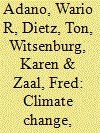

|
|
|
|
|
| Publication |
2012.
|
| Summary/Abstract |
Many regions that are endowed with scarce natural resources such as arable land and water, and which are remote from a central government, suffer from violence and ethnic strife. A number of studies have looked at the convergence of economic, political and ecological marginality in several African countries. However, there is limited empirical study on the role of violence in pastoral livelihoods across ecological and geographical locations. Yet, case studies focusing on livelihood and poverty issues could inform us about violent behaviour as collective action or as individual decisions, and to what extent such decisions are informed or explained by specific climatic conditions. Several case studies point out that violence is indeed an enacted behaviour, rooted in culture and an accepted form of interaction. This article critically discusses the relevance of geographical and climatic parameters in explaining the connection between poverty and violent conflicts in Kenya's pastoral areas. These issues are considered vis-à-vis the role institutional arrangements play in preventing violent conflict over natural resources from occurring or getting out of hand. The article uses long-term historical data, archival information and a number of fieldwork sources. The results indicate that the context of violence does not deny its agency in explanation of conflicts, but the institutional set-up may ultimately explain the occurrence of the resource curse.
|
|
|
|
|
|
|
|
|
|
|
|
|
|
|
|
| 7 |
ID:
157538
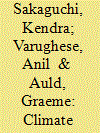

|
|
|
|
|
| Summary/Abstract |
Global climate change has been connected to myriad societal and environmental consequences, including the potential for a rise in violent conflict. To advance understanding of violent conflict as a threat, we undertake a systematic review of peer-reviewed, empirical analyses examining the potential links between climate change and violent conflict. The review reveals three key findings. First, the reviewed studies offer mixed and varied evidence for links between climate change and violence. A majority of studies find evidence that climate variables are associated with higher levels of violent conflict. However, this general pattern masks many subtleties and countertrends that complicate moving to a simple conclusion that the link between climate change and violence is robust. Second, most studies hypothesize an indirect relationship between climate change and violent conflict mediated by and/or interacting with a complex set of intervening variables; however, these causal pathways have only weak empirical support. Third, the empirical basis of the literature has important limitations. Study findings appear to be sensitive to differing methodological choices, making systematic assessments inconclusive.
|
|
|
|
|
|
|
|
|
|
|
|
|
|
|
|
| 8 |
ID:
166807


|
|
|
|
|
| Summary/Abstract |
This article analyzes and compares four results of public opinion surveys conducted through the coordination of academic institutions in Thailand's Deep South. Based on the concepts of the conflict transformation, the study indicates, in the survey data conducted from 2015 to 2017, that people in the Deep South have had mixed feelings about the ongoing peace talks and the violent situation. The more open form of autonomous governance has been advocated by a sizable number of people, but the spiral of silence dominating the “no comment” groups still makes it problematic to predict the future. More studies need to be done and the article also shows that the survey research, if carried out properly, could reveal the unseen drivers of change in the conflict society.
|
|
|
|
|
|
|
|
|
|
|
|
|
|
|
|
| 9 |
ID:
133090
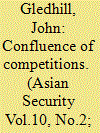

|
|
|
|
|
| Publication |
2014.
|
| Summary/Abstract |
In April 2006, riots broke out on the streets of Dili. As violence escalated over the weeks that followed, a beacon of liberal peace-building dissolved into near-anarchy. While there have been several accounts of Timor-Leste's "crisis" of 2006, it remains unclear why violence spiraled at that time, rather than at an earlier point in the country's post-conflict transition. This article addresses that temporal puzzle by combining an analysis of the structural origins of the crisis with discussion of proximate, agency-driven triggers to violence. The resulting narrative first details the development of competition between governing elites, and also between state security actors, over the years following independence. The fusion of those two dynamics of competition in 2006, I then argue, created conditions sufficient for violent conflict.
|
|
|
|
|
|
|
|
|
|
|
|
|
|
|
|
| 10 |
ID:
112940
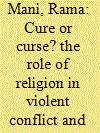

|
|
|
| 11 |
ID:
133255
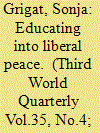

|
|
|
|
|
| Publication |
2014.
|
| Summary/Abstract |
Indonesia has seen excessive political violence in the first years since the end of autocratic rule under former president Suharto. Documented violence has ranged from separatist struggle to communal strife to terrorist attacks. The International Crisis Group (icg) has reported extensively on the conflicts underlying this violence and has formulated policy advice on how to overcome them. While the icg's reports on Indonesia have been acknowledged for their detailed and accurate account of micro-level violence, their recommendations reveal their political objectives. The icg's panacea for overcoming violent conflicts is institution building and security sector reform, which are centrepieces of the 'standard programme' of liberal peace- and state building. However, it is not only its policy advice but all the icg's publications in general that aim to diffuse the liberal governance agenda. This article argues that, through the narrative technique of epideictic oratory, the icg is aiming to educate its audience into a liberal governmentality characterised by practices and procedures which effect a de-politicisation of violence, foster liberal forms of governance and self-government and thus contribute to sustaining liberalism as a global 'regime of power'.
|
|
|
|
|
|
|
|
|
|
|
|
|
|
|
|
| 12 |
ID:
163502
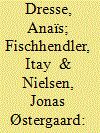

|
|
|
|
|
| Summary/Abstract |
Environmental peacebuilding represents a paradigm shift from a nexus of environmental scarcity to one of environmental peace. It rests on the assumption that the biophysical environment’s inherent characteristics can act as incentives for cooperation and peace, rather than violence and competition. Based on this, environmental peacebuilding presents cooperation as a win-win solution and escape from the zero-sum logic of conflict. However, there is a lack of coherent environmental peacebuilding framework and evidence corroborating the existence of this environment-peace nexus. Building on a multidisciplinary literature review, this article examines the evolution of environmental peacebuilding into an emerging framework. It unpacks the concept and explains its main building blocks (conditions, mechanisms and outcomes) to develop our understanding of when, how and why environmental cooperation can serve as a peacebuilding tool. It assembles these building blocks into three generic trajectories (technical, restorative and sustainable environmental peacebuilding), each characterised according to their own causality, drivers and prerequisites, and illustrated with concrete examples. Finally, this article draws attention to the remaining theoretical gaps in the environmental peacebuilding literature, and lays the foundations for an environmental peacebuilding research agenda that clarifies if and how environmental cooperation can spill over across borders, sectors and scales towards sustainable peace.
|
|
|
|
|
|
|
|
|
|
|
|
|
|
|
|
| 13 |
ID:
120007
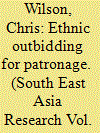

|
|
|
|
|
| Publication |
2013.
|
| Summary/Abstract |
Do local systems of patronage in Indonesia cause or prevent intercommunal violence? In analysing the September 2010 ethnic riots in Tarakan, East Kalimantan, this article illustrates one mechanism by which clientelism can lead to violent communal conflict. Ethnic organizations claiming to represent the marginalized indigenous community engaged in a form of 'ethnic outbidding' in order to intimidate their way into local patronage networks. Apparent leadership of an aggrieved indigenous community gave organizations access to state resources that they would not otherwise have had. In order to sustain this status, however, these organizations were obliged to respond vigorously to any apparent insults to the community, thereby increasing the risks of intercommunal conflict.
|
|
|
|
|
|
|
|
|
|
|
|
|
|
|
|
| 14 |
ID:
153630
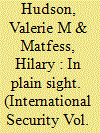

|
|
|
|
|
| Summary/Abstract |
Approximately seventy-five percent of the world's population lives in countries where asset exchange upon marriage is obligatory. Rising brideprice—money or gifts provided to a woman's family by the groom and his family as part of marriage arrangements—is a common if overlooked catalyst of violent conflict. In patrilineal (and some matrilineal) societies where brideprice is practiced, a man's social status is directly connected to his marital status. Brideprice acts as a flat tax that is prone to sudden and swift increases. As a result, rising brideprice can create serious marriage market distortions that prevent young men, especially those who are poor or otherwise marginalized, from marrying. This phenomenon is especially evident in polygamous societies, where wealthy men can afford more than one bride. These distortions incentivize extra-legal asset accumulation, whether through ad hoc raiding or organized violence. In such situations, rebel and terror groups may offer to pay brideprice—or even provide brides—to recruit new members. Descriptive case studies of Boko Haram in Nigeria and various armed groups in South Sudan demonstrate these linkages, while an examination of Saudi Arabia's cap on brideprice and its efforts to arrange low-cost mass weddings illustrates the ways in which governments can intervene in marriage markets to help prevent brideprice-related instability. The trajectory of brideprice is an important but neglected early indicator of societal instability and violent conflict, underscoring that the situation and security of women tangibly affect national security.
|
|
|
|
|
|
|
|
|
|
|
|
|
|
|
|
| 15 |
ID:
087420


|
|
|
|
|
| Publication |
2009.
|
| Summary/Abstract |
On 14 July 2008, after much advance publicity and fanfare, the procecutor of the International Criminal Court (ICC), Luis Moreno-Ocampo, applied for a warrant of arrest against the president of Sudan, Omar Hassan Ahmad al-Bahsir, on charges that included conspiracy to commit genocide along with other war crimes.
|
|
|
|
|
|
|
|
|
|
|
|
|
|
|
|
| 16 |
ID:
158452
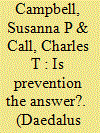

|
|
|
|
|
| Summary/Abstract |
Is prevention the answer to escalating violent conflict? Conflict prevention uses carrots and sticks to deter future violence. Its power thus rests on the credibility of policy-makers' commitment to supply the carrot or stick in a timely manner. Unfortunately, there are several political and bureaucratic barriers that make this unlikely. First, it is difficult for policy-makers to sell preventive actions to their constituencies. In contrast with core security interests (like nuclear warfare), an uptick in violence in a faraway, nonstrategic country provides a less convincing call for action. Second, preventive decisions are difficult to make. Decision-makers are predisposed to avoid making difficult decisions until a crisis breaks out and they are forced to act. Third, preventive actions are political, not technical, requiring the use of precious political capital for uncertain outcomes whose success may be invisible (manifest in the absence of violence). Perhaps, if decision-makers are able to overcome these obstacles and make more credible commitments to conflict prevention, then conflict prevention will become a more credible solution to violent conflict.
|
|
|
|
|
|
|
|
|
|
|
|
|
|
|
|
| 17 |
ID:
155007


|
|
|
|
|
| Summary/Abstract |
This paper argues that violent conflict prominently impacts on land governance and so contributes to land conflicts in post-conflict settings. In the natural resources literature, the relationship between land and conflict is often explained in terms of environmental security or political ecology, and many have pointed out that the way land is governed in itself may be a source of conflict. However, less attention has been given to the effects of violent conflict on land and its governance in post-conflict situations. This paper argues that violent conflict affects land governance in many ways and that this in turn might contribute to further violent conflict. The argument builds around an extended case study of the Apaa evictions in Amuru District in Northern Uganda. The case illustrates how conflict around land is not just the result of resource scarcity and competition, but is the outcome of a combination of political, historical and social dynamics. Past policies on land and practices of land governance play a critical role in this. However at the same time, violent conflict has a critical impact on land access, transforms land governance authority and the rules applied. The land conflicts resulting from this, in turn, fuel ethnic tensions between local population groups, and grievances about those in power and the institutions that govern natural resources. The ways in which such problematic conflict-induced changes in land access and governance are dealt with by policymakers is critical for post-conflict stability.
|
|
|
|
|
|
|
|
|
|
|
|
|
|
|
|
| 18 |
ID:
132316
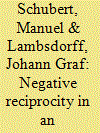

|
|
|
|
|
| Publication |
2014.
|
| Summary/Abstract |
How is negative reciprocity cultivated in an environment of violent conflict? This study investigates how students in the West Bank react to unfair proposals in an ultimatum game. Proposals submitted with Hebrew as compared to Arab handwriting are rejected more often. Israelis must offer 15 percent more of a given stake than Palestinians in order to achieve the same probability of acceptance. This willingness to lose money by rejecting proposals reveals a preference for discrimination against Israelis, cultivated in the conflict-ridden environment. Students who voice a militant attitude, surprisingly, do not reveal a higher tendency to discriminate, exercising a high degree of negative reciprocity toward all unfair proposals. But those who favor a political role for Islam have a higher inclination to discriminate. This implies that ethnic and religious cleavages do not consistently generate in-group solidarity.
|
|
|
|
|
|
|
|
|
|
|
|
|
|
|
|
| 19 |
ID:
052815
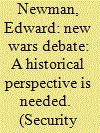

|
|
|
| 20 |
ID:
088353
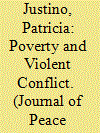

|
|
|
|
|
| Publication |
2009.
|
| Summary/Abstract |
This article discusses how endogenous mechanisms linking processes of violent conflict and the economic well-being of individuals and households in combat areas provide valuable micro foundations to the ongoing debate on the causes and duration of armed conflict. Notably, the endogenous relationship between conflict processes and household economic status leads to the emergence of symbiotic associations between armed groups and households living in areas they control that affect substantially the probability of a conflict starting and its effectiveness thereafter. Households in conflict areas draw on local armed groups to protect their economic status when anticipating violence and during the conflict, while armed groups make use of different levels of (either reluctant or voluntary) participation, support and cooperation from local populations to advance their strategic objectives at the onset and throughout the conflict. The level of household participation at the start and during the conflict is a function of two interdependent variables, namely household vulnerability to poverty and household vulnerability to violence. The poorer the household is at the start of the conflict, the higher is the probability of the household participating and supporting an armed group. The higher the risk of violence, the higher is the probability of the household participating and supporting armed groups. The interaction between these two variables varies with the conflict itself and is defined by the direct and indirect effects of conflict-induced violence on the economic behaviour and decisions of households in combat areas.
|
|
|
|
|
|
|
|
|
|
|
|
|
|
|
|
|
|
|
|
|